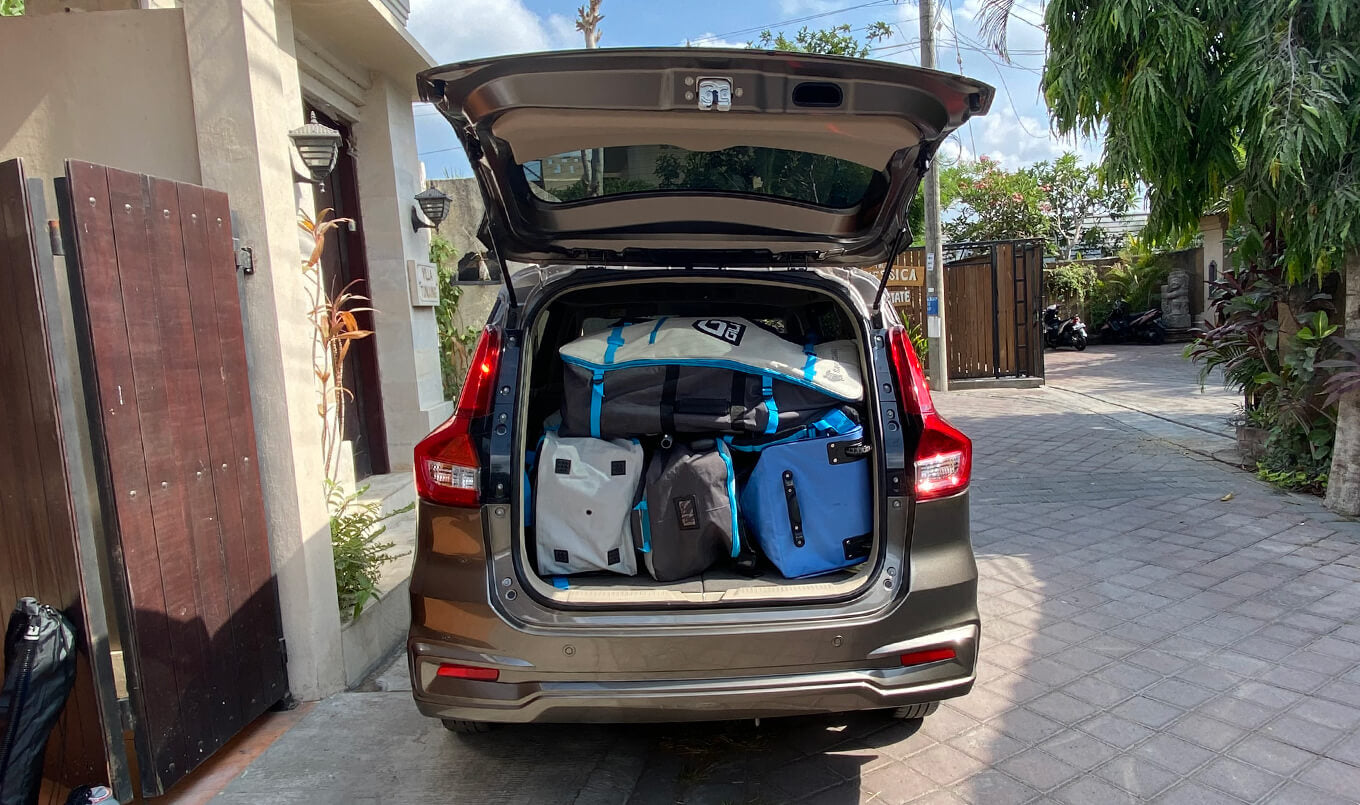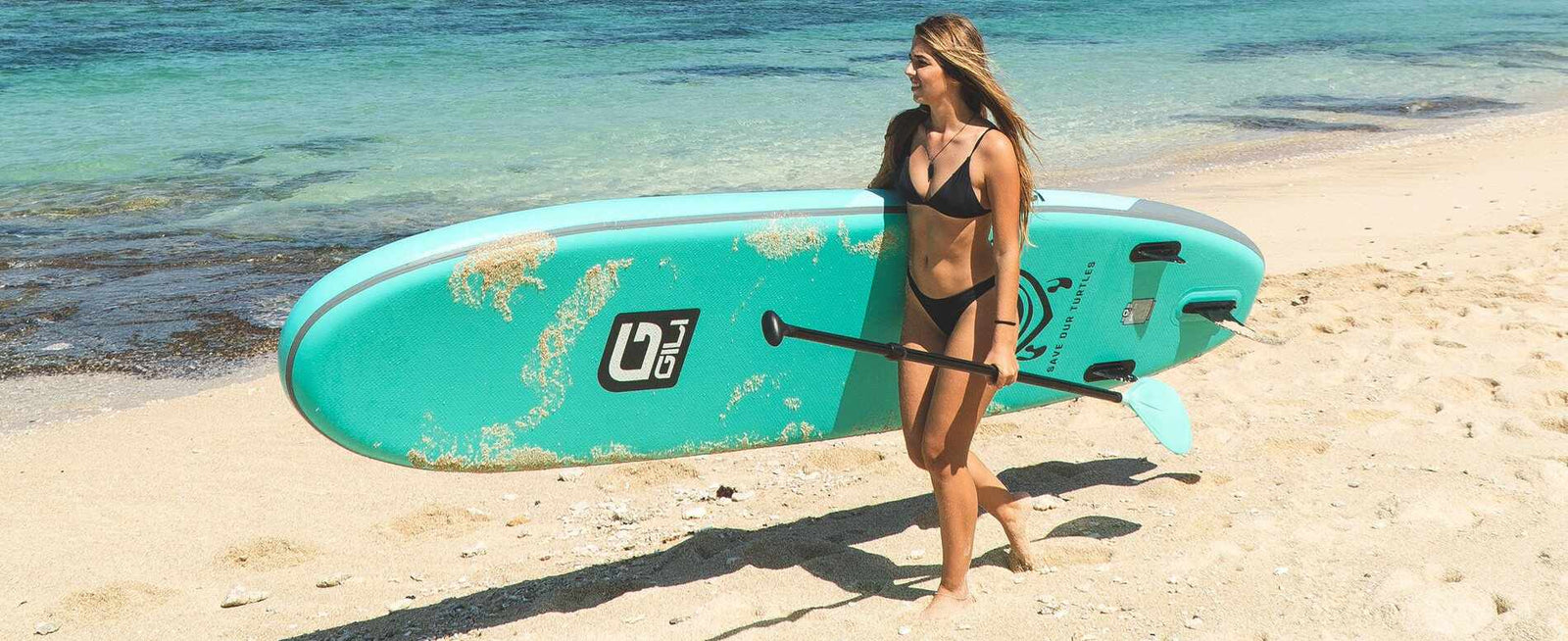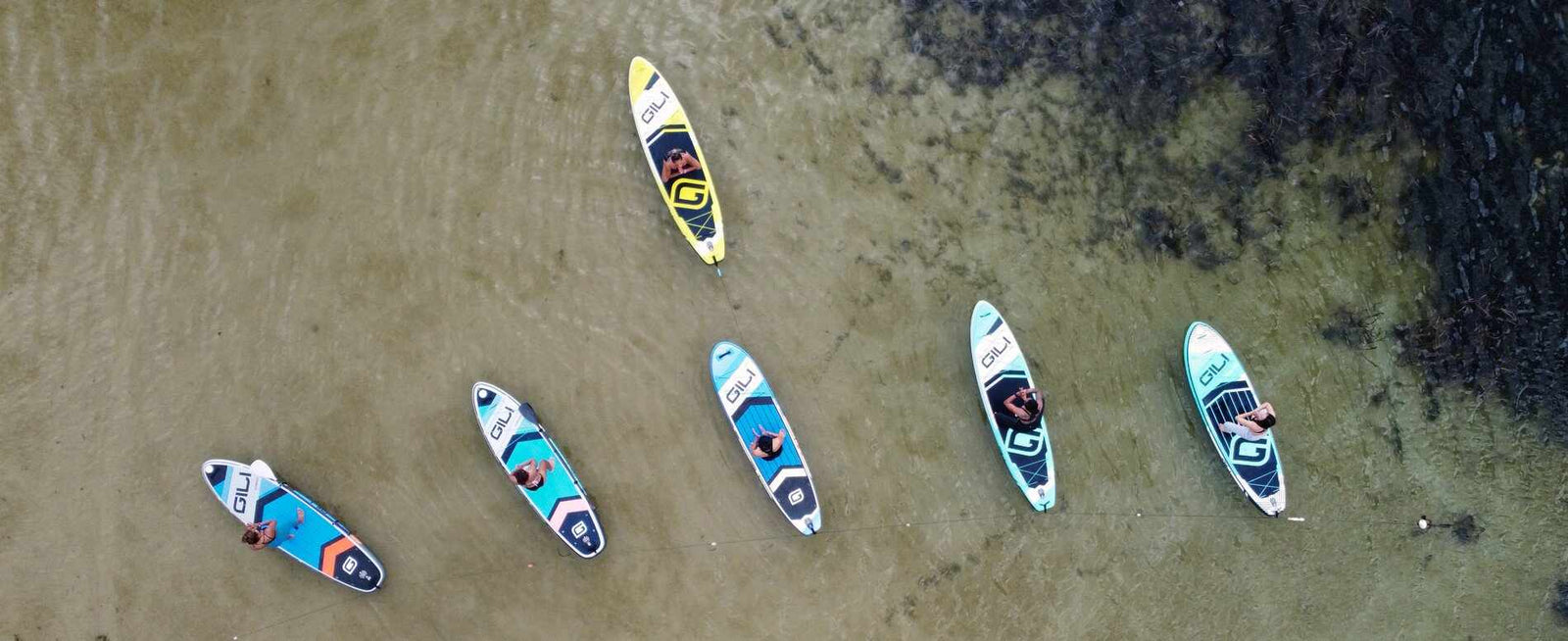Your Cart is Empty

What Size Paddle Board Do I Need?
Paddle Board Sizing Guide
Love SUP but overwhelmed by all the different shapes and sizes of stand up paddle boards? Dude, we’re here to help! The very first step is choosing the right board - and to do that, you’ll need to figure out what size paddle board you need. Here’s how to choose the perfect SUP size for you.
Topics Covered in this Article
- 1. Key Factors to Paddle Board Sizing
- 2. What Size Paddle Board Do I Need For My Weight?
- 3. What Is The Best Paddle Board For Beginners?
- 4. Best SUPs For Intermediate And Advanced Paddlers
- 5. What Volume Should My Paddle Board Be?
- 6. What Length Should Your Paddle Board Be?
- 7. How Wide Should Your Paddle Board Be?
- 8. How Thick Should My Paddle Board Be?
- 9. What Size Paddle Board Do I Need For My Height?
- 10. Paddle Board Sizing By Activity
- 11. Quick Paddle Board Size Tips
Key Factors to Paddle Board Sizing
To find the right size SUP, you’ll need to know four key dimensions:
- Volume: The buoyancy of your SUP, measured in liters.
- Length: Your SUP’s measurement from top to bottom.
- Width: Your SUP’s measurement from side to side.
- Thickness: The distance between the top of your SUP and the bottom of your SUP.

What size paddle board do I need for my weight?
The most important factor in SUP size is your weight. (And don’t forget that you need to factor in the weight of any SUP companions - dogs, humans, or otherwise - that you’ll have on the board with you.) Along with your weight, your skill level will also help you determine which the volume your SUP should be.
To find out a SUP’s weight capacity, you’ll need to know your board’s volume. Volume is the liter-based measure that determines your SUP’s buoyancy based on length, width, and thickness. (Volume is listed in liters on all GILI boards, so you’ll never have to guess.) This might sound like a lot of facts and figures, but it’s easier than it sounds!
You cannot be underweight for a SUP, but if you exceed your SUP’s weight capacity the board will drag, be unstable, and you'll have a bad experience!
The higher the volume a board has, the more weight it can support. If you go for a board that’s too low in weight capacity, you’ll be in for a long, unstable ride that feels more like a drag than a breezy paddle.
Inflatable SUP Volume:
- People under 200 lbs: You'll be fine on any standard paddle board
- People 200-235 lbs: At least 175 L of volume
- People 235-300 lbs: At least 242 L of volume
- People over 300 lbs: At least 272 L of volume
Hard/Epoxy SUP Volume:
- People under 200 lbs: Any standard SUP will float you
- People 200-235 lbs: At least 175 L of volume
- People 235-275 lbs: At least 181 L of volume
- People over 300 lbs: At least 230 L of volume
Is there a weight limit on paddle boards?
No matter your size or weight, you can have fun on a SUP! Seriously, there’s a board out there for just about every weight range. The important thing is ensuring that whatever board you choose has a weight capacity that exceeds your weight.
In addition to following weight capacity guidelines, determine the capabilities of your board’s hull type. If the board has a rounded nose (known as a planing hull), it can manage weight more flexibly. Displacement hulls, on the other hand, won’t perform as well if a paddler is over the weight capacity.

Remember, you can’t be too light for a paddle board! however, exceeding the weight capacity of your SUP makes for a poor paddling experience.
What size paddle board do I need for my height?
When it comes to SUP functionality, your height is far less important than your weight and the weight of your gear. If anything, your height will play a role in how you size your paddles (paddles should extend 8-10” above your head), but most paddles are adjustable to just about any height. Choose your board size based on your weight, the weight of anyone you’d like to bring on board, and the gear you plan to take with you. Leave the height calculations for later when you’re setting up your paddle.
What is the Best Paddle Board for beginners?
If you’re just getting started with SUP, find a board with a width of 31” or more, and a volume that can support your weight. (We’ve got you covered with common SUP beginner volumes below.) An inflatable board is excellent for any skill level, but its stability makes it a particularly great beginner board.

Ideal Beginner SUP Size
- Inflatable SUPs: 220-280 L, 10’6 to 11’ long, and 31” to 35” wide
- Hard/Epoxy SUPs: 170-190 L, 10’6-11’ long, and 32” to 35” wide
The Best SUPs for Intermediate and Advanced Paddlers
Once you’ve got your basic SUP skills down to a science, your choice of board size becomes more about which activities you plan to do on your SUP, rather than stability. More advanced paddlers thrive on boards with less volume. While any width is doable for a well-versed paddler, many prefer narrow boards for their speed.
Ideal Intermediate/Advanced SUP Size
- Inflatable SUPs: 200-250 L, 10'-12’6 long, and 30” to 33” wide
- Hard/Epoxy SUPs: 165-195 L, 10'-12’6 long, and 29” to 32” wide

What volume should my paddle board be?
As we mentioned earlier, the volume of your SUP determines your board’s buoyancy (measured in liters). This is calculated by multiplying the board’s length, width, and thickness. The higher your SUP’s volume, the higher its weight capacity. Higher board volume also equates to more overall stability.
Generally, if you're under 200 lbs, any standard paddle board will be able to float you just fine. If you're over 235 lbs, you'll want a board with at least 175 L of volume in order for increased stability. For the over 275 lbs, grab a board with over 240 L of volume. If you're over 300 lbs, choose a board with at least 270 L of volume for the proper stability and control.
How to Calculate Your Ideal Paddle Board Volume
If you ride a paddle board that's does not have enough volume for your weight, the board will drag in the water, it will be slow to paddle, and it will be too unstable to ride comfortably.
Note: a SUP’s volume and weight capacity should always be listed in its spec sheet.
What length should your paddle board be?
The most popular length range for a paddle board is between 10’ to 11’ long, and that range is a great choice for an all around SUP. Length recommendations aren’t always directly related to your SUP skill level or your weight - instead, it’s all about what you plan to do with your SUP. While weight canplay some factor in how your board length pans out for you, the SUP activities you prefer are much more important.

If you plan to SUP surf or have a smaller body type, a shorter board (10’ or less) is your best bet. Shorter boards are more agile and move swiftly in choppy waters. They’re also a great option for kids. If you mainly want to paddle long distances or go SUP touring, seek out a longer board (11’ or longer) for smooth, efficient paddling.
When zeroing in on length, envision where you’ll store your board and how far you’ll be carrying it. Inflatable paddle boards are less of a storage concern than hard boards, and generally, a shorter SUP is easier to store. Another thing to keep in mind: longer boards can be harder to carry, especially in windy weather. If you have to trek a long way to the water, you’ll get sick of dragging a longer board pretty quickly.
If this is your first SUP, shoot for a length of at least 10’6 or 11 feet - you’ll thank us later!
Your paddle board’s length doesn’t just impact the quality of your ride. It can also make or break your SUP storage situation back on land. If buying a hard board, remember you’ll need to transport it to and from the water and store it inside in a cool, dry place.
Paddle Boards Under 10’
- Excellent for SUP surfing
- Super maneuverability for catching waves and performing bottom turns
- Awesome for kids 13 or younger
- Have planing hulls
- Good for intermediate or advanced paddlers and SUP Surfers
Paddle Boards over 10’ to 11’6
- Most popular SUP size
- A fantastic choice for an all-around SUP
- Usually 31” to 35” wide
- Great for all paddlers from beginner to intermediate and advanced skill levels
- Ideal for recreational paddling, SUP fishing, and SUP yoga
- Most have planing hulls, with a few exceptions
- Our favorite fishing SUPs (ideally with a width of 32” or more)
Paddle Boards Of 12’ Or More
- Best for intermediate to advanced paddlers
- Good choice for long-distance paddling, racing, and touring
- Fast moving, efficient SUPs that slice through the water
- Most have displacement hulls
- For SUP racing, choose one less than 31” wide
- For SUP touring, choose one that is 32” wide
- For SUP fishing Choose a board at least 32” or wider
How wide should your paddle board be?
Weight capacity is just the tip of the iceberg. Here’s what else goes into sizing your SUP.
SUP Width
Paddle board width, or its side-to-side measurement, should be between 29” to 35”. A wider board will be more stable on the water, while a narrower board will move faster. When you’re choosing your SUP width, think about your skill level and what kinds of SUP activities you’re interested in. A wider board (32” or more) is easier for a beginner who’s still finding his balance, while experienced paddlers will do fine with just about any paddle board width.

If you’re planning on using your board for SUP yoga, SUP fishing, or general recreational paddling, choose a board that’s at least 31” wide. If you’ll be SUP surfing or doing a speed-focused activity like racing, grab a narrower board: 29” to 31” wide.
Consider your body type as well when deciding on width. If you’re taller or heavier, a larger width is easier to balance on. If you have a small frame and some paddling experience under your belt, a narrower board is more fun to maneuver.
Beginner SUP Width: 31 to 35 inches
Advanced SUP Width: 29 to 33 inches
How thick should my paddle board be?
Paddle board thickness is the distance between the top and bottom of the board. Inflatable paddle boards should be at least 6” thick. (All GILI boards are.) Inflatable boards with a smaller thickness than that will lack the stability and performance quality you need.
There are plenty of poorly made iSUPs on the market that are not thick enough to function properly. If you see an iSUP with a 4”-5” width, run far, far away! A 5” board can seem functional for a short time, but it will eventually cave under too much weight. And 4” boards are so dysfunctional that they’re becoming straight-up obsolete. The last thing you want is for your board to stop supporting you when you’re out in the middle of the water. It’s just not worth it!
Hard paddle boards are typically between 4” to 4.5” thick. If you’re choosing a hard SUP, know that thinner boards are usually faster than thicker boards. For a hard/epoxy SUP, thickness is more application-specific, and you’ll need to pay more attention to volume than thickness.
When riding an iSUP, you’ll notice that the thickness is the same throughout the board, whereas hard boards have a bit of curve underneath (rocker) to reduce weight. Because of this, iSUPs are more stable.

Paddle Board Sizing by Activity
Already have a favorite SUP hobby in mind? Here’s what size you’ll need.
All Around Paddling
For general recreational SUP, get an all-around board that’s versatile while still being stable and maneuverable. The most common size range of SUP boards for general use are 10’ to 11’ long and 31” to 35” wide. All Around Paddle Boards make excellent beginner SUPs.
SUP Yoga
If you love SUP yoga (or SUP pilates!), find a board that is wide enough for you to balance as you work on that warrior pose. Choose a width between 31” to 35” and a length of 10’ to 11’6.
SUP Fishing
You’ll need extra space for gear, so SUP fishing is best on a board that is between 10’6 to 12’ long and 32” to 36” wide. Make sure your SUP is ready for the catch with extra bungees, d-rings, and Scotty mounts.
SUP Touring
If you mainly want to go touring on your SUP, seek out a longer board (11’ to 12’6) for easy gliding. A displacement hull and a width between 30” and 33” will help ensure a smooth journey. Touring SUPs also make great adventure SUPs.
SUP Surfing
For SUP surfing, choose a shorter board of 10’ or less. Choose a narrow board (29” to 32” wide) so you can seamlessly paddle among the waves. This is best for more advanced paddlers!
Hybrid SUPs
Hybrid paddle boards are wider than a typical all around SUP and usually feature a pointed nose. These paddle boards are extra stable for exercise, SUP Yoga, riding with your dog and/or kids. These boards are super versatile and growing in popularity.
Whitewater Paddling
Hit those fast-moving waters with an extra small board: between 6’ to 8’ long is ideal. You’ll need a super-wide SUP, 34” to 36”, to navigate all that whitewater!
Quick Paddle Board Size Tips
Keep these facts front of mind when choosing your SUP.
Choosing a board size is just the beginning of your SUP journey. Don't buy a board without understanding hull types, fin systems, differences between hard/epoxy and inflatable SUPs, SUP construction, and other unique details. Check out our article on How To Choose A Stand Up Paddle Board for even more info.
Most Popular SUP Size
The most popular SUP sizes for all-around paddling are 10’6 to 11’ long and 31 to 35” wide.
Specialized SUP Sizes
Specialized SUP sizes are ideal for special activities like surfing, racing, or whitewater SUP. You can maneuver deftly on these boards because they’re shorter than an all around board. If your favorite SUP activity is speed-related (like surfing or racing), shorter boards are best.
Inflatable SUPs Are Ideal
Inflatable SUPs are much easier to store and transport than hard boards. iSUPs have a uniform thickness, while hard SUPs have a curve in the middle where the thickness changes. This is meant to reduce overall weight of hard boards and make them board faster, but the tradeoff is a loss of stability for beginners. If you want a stable ride, iSUPs are generally the way to go!
SUP Thickness Is Just As Important As Shape, Length, And Width
Board thickness doesn’t get as much attention as other factors, but it’s a make or break for your SUP adventures. Choose iSUPs that are at least 6” thick, like all GILI boards are, or you’ll struggle to stay afloat.
For hard SUPs, look for a thickness around 4 to 4.5”, but this will depend on your application and use of the board.
Check Your Storage and Transport Options
Inflatables are much easier to Store and Transport than Hard Boards. Inflatables will pack up in the trunk of your car, but an epoxy SUP will require a car roof rack and a garage to store it!

It’s All In The Details
Size is important when choosing a SUP, but other details like construction, hull type, and fin systems are important too.The construction of your board ( whether it’s inflatable, soft top, or hard/epoxy) makes a difference in how smoothly it rides and how you intend to use it.
Also, be aware of your board’s fin system. A SUP needs at least one main fin to track in a straight line. The most popular fin setups are one single fin or a 2+1 setup, where you’ll have two side fins in addition to your center fin. There are also more complex setups, like quad fin systems, for specialized activities like surfing. For most paddlers, a 2+1 is ideal.
Summing Up: If The SUP Fits, Use It
When you know what size SUP is right for you, you’ll have a board that lasts you many years and many adventures. When you know what size SUP you need, head over to our SUP Size and Weight Chart.
At the end of the day, your skill level, weight, and your intended SUP activities will guide you to the right board. Do you have any more questions about choosing the right size paddle board? Ask us in the comments.
Leave a comment
Comments will be approved before showing up.


